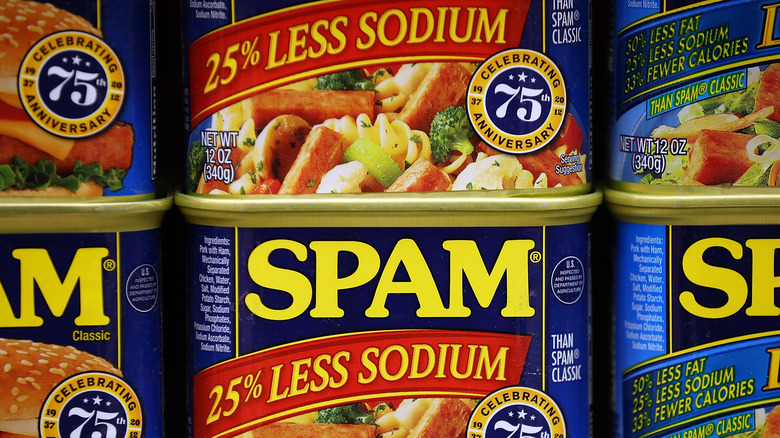Here's How Long Canned Meat Really Lasts On Your Shelf
If one were to peek inside the collective pantries of American home cooks, they'd probably find the remnants of what Eater refers to as "Panic Beans": the cans upon cans of legumes that shoppers purchased in droves at the start of the pandemic in a hive-mind state of survivalism (read: panic). According to the New York Times, bean businesses and packagers had to add shifts to keep up with the increase in demand.
It makes sense that shelf-stable items and frozen foods were (and still are) making a comeback. Back when most supermarkets were operating at reduced capacity to slow the spread of the coronavirus and people bought more groceries less frequently, canned-food shortages became par for the course. With a lifespan of two to five years, beans seemed to be a necessity in the era of COVID-19.
But what about canned beans' decidedly less-popular cousin, canned meat? According to a 2020 survey from the Hamburg-based data collectors at Statista, roughly 100 million U.S. consumers claimed to eat canned meat against the 226 million who said they didn't. Carnivores already sold on the stuff might pick up canned lunch meat (Spam musubi, anyone?) over canned sausage, but whatever the buyer chooses, they're sure to be surprised at how long their new protein-packed pantry additions will last on the shelf. Skeptics, take note.
Use by: 2027
Cans of meat and poultry are preserved in the same way as many fruits and vegetables. They're "hermetically sealed" in a "tin-coated steel can" to make sure no air can get in, and then "thermally processed to destroy spoilage microorganisms" (via Science Direct).
Unlike the pork shoulder in your fridge, canned meat can last anywhere between two to five years, per the USDA, and sometimes up to up to 10 years. This is due to both the canning process and meat's low acid content. High-acid preserved foods like tomatoes, lemons, and grapes will keep in their cans for a comparatively short 18 months.
Expiration dates aside, outside factors like high heat and denting can mess with the safety of preserved food, so it's always best to rely on your senses to determine whether your canned meat has gone bad. The FDA recommends checking the can for swelling — if you can feel space between the tin and the meat inside or if you see liquid oozing from the lid, you're better off ditching it. Do the same if the meat appears cloudy, mushy, or sour-smelling. Trust your eyes, trust your nose, and trust that gut feeling. As long as you keep your canned meat in a cool, dry place and enjoy it by its best-by date, you're most likely in the clear.
The peculiar origin story of canned food
Wait a minute ... you're telling us you've never researched the origin story of the smoked ham you impulse-bought at CVS two years ago? We're shocked, but we're more than happy to explain.
While it would be reasonable to assume that canned food was the innovation of scientists in a lab, it was actually the product of a national competition sanctioned by the French government at the end of the 18th century. According to History, the leaders of the country teamed up with the Society for the Encouragement of Industry to advertise a 12,000-franc prize for the citizen who came through with the best development in food preservation. Why? Droves of French soldiers were stationed in Italy, the Netherlands, Germany, and the Caribbean at the time, and they were in desperate need of nourishment that didn't require refrigeration.
Enter: Nicolas Appert, not a scientist but a chef living in the wine region of Champagne who had previously served as a chef for the French nobility, per History. True to his region of residence, Appert devised an ingenious method: packing food in Champagne bottles and sealing them "with an oddly effective mixture of cheese and lime." After successfully testing his products on the French navy in 1803, (by which time he had become the proprietor of a canned food lab and factory), it was only one more year before he started experimenting with canned meat. Et voilà — a star is born.
Cooking with SPAM, a decidedly tasty canned meat
There's no denying that the differences between canned meat and fresh meat extend beyond packaging alone. To become worthy of your zombie-apocalypse stash, canned meat sometimes needs a little extra push from additives to stay edible for a long time. As a result, certain brands have been known to carry less-than-appetizing aromas and textures.
Back in 2016, Thrillist conducted a taste test of 11 different canned meat brands and reasoned that, while some weren't totally vile options for your bunker, SPAM stood out as a legitimately appealing pork product. ("Wow! This is completely fine! Good even! No wonder this sucker's so famous.")
We've already shouted out musubi, but Serious Eats has even more amazing, unexpected ways to use SPAM. The outlet suggests spicy SPAM hash with potatoes, onions, peppers, and eggs; SPAM burgers that treat slices of the canned pork like strips of bacon atop a beef patty; SPAM mac and cheese; SPAM Wellington; "Spamghetti Carbonara"; and SPAM tacos, which are a good opportunity to make use of the brand's jalapeño flavor. Of course, you could always keep it classic by frying up a couple strips of the stuff and serving them with fried eggs and toast; the possibilities are endless.



